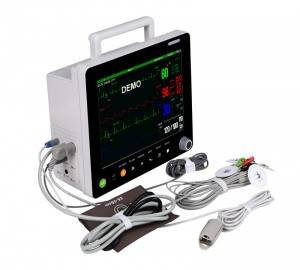“The monitor can monitor the patient’s ECG, blood pressure, respiration, body temperature and other parameters synchronously and continuously, providing a good means for medical staff to grasp the patient’s condition comprehensively, intuitively and in a timely manner. With the gradual modernization of the hospital, More monitors will enter the clinic and become the most commonly used medical equipment in the ward. Therefore, it is particularly important to do a good job in the maintenance and maintenance of the monitors. Only when the maintenance and maintenance work is done can the monitors be in good working condition. At the same time, it can reduce the failure rate, prolong the life of various sensors, components and the whole machine, thereby reducing the cost of hospital treatment. Summarizing the past work experience, the maintenance and maintenance of the monitor mainly include the following aspects:
The monitor usually works continuously for a long time, and it is easy to cause premature aging or even damage of the internal components due to the high temperature inside the machine. Therefore, we must do a good job of cleaning the inside and outside of the machine to ensure that the machine has good heat dissipation and ventilation. In a few months, check the filter on the host to clean the dust on it. At the same time, check the surface of the operation panel and the display, and use anhydrous alcohol to remove the dirt on it, so as not to corrode these important parts. Every six months to one year, the machine casing should be disassembled and the inside of the machine should be dusted. While removing dust, you can use intuitive methods such as “seeing, smelling, and touching” to inspect each module and component in the machine. Maintenance and maintenance of the sensor: Due to the characteristics of the sensor itself and the part of the patient it detects are often in motion, it is an easily damaged part and an important and expensive part. In order to prolong their service life and reduce the cost of treatment, we should do a good job in their maintenance. Communicate frequently with healthcare professionals to instruct them on proper operation and maintenance of monitors and sensors. Do not fold or pull the sensor transmission wire; do not drop or touch sensor probes such as blood oxygen saturation probes, temperature probes, and invasive blood pressure probes. For the non-invasive blood pressure cuff, when it is not tied to the patient, the host cannot measure at this time, so as not to damage the inflated air bag. For the monitor that needs to monitor for a long time without monitoring blood oxygen saturation, this function can be turned off by adjusting the system configuration. If the machine has this setting or unplug the interface connecting the blood oxygen saturation to the host, the monitor Generally, each sensor is connected through an interface, thereby extending the service life of such a sensor. The sensor probe is easily contaminated with various dirt such as sweat and blood. In order to avoid corrosion of the probe and affect the measurement, the probe should be cleaned regularly according to the method provided in the user manual.

system maintenance
Improper, or even wrong, monitor systems can often cause problems for healthcare workers. For example: there is an ECG waveform, but no heart rate; blood pressure cannot be measured for hypertensive patients; each parameter shows normal, but the alarm continues, etc. These may be caused by incorrect system settings. Therefore, it is necessary to check and maintain the system frequently to ensure the reliability and optimality of monitoring, that is, the best configuration. Although the monitors are various and the specific methods of system settings are different, most of them have the following aspects: Patient information In these information, it is necessary to pay attention to the correct selection of “patient type”. They are generally divided into adults, children, and newborns. They use different measurement schemes. If the wrong choice is made, the accuracy of the measurement will be affected or even impossible. For example, non-invasive blood pressure may not be measured and display errors.
Function settings
The best effect can be achieved by adjusting the function settings of each parameter. For example, adjust the wave amplitude and wave speed to make the displayed waveforms easy to observe; use various bandwidth filtering functions to eliminate the interference of different frequencies such as power frequency and EMG; and set the display channel, system clock, alarm volume, screen brightness, etc. Wait. The alarm configuration correctly sets the upper and lower alarm values of each parameter. To avoid false positives. Of course, with the continuous development of monitors, more new materials and new technologies will be applied to them. We must continue to learn, explore in the work, improve and develop the maintenance and maintenance of the monitor.”
Post time: Mar-14-2022

